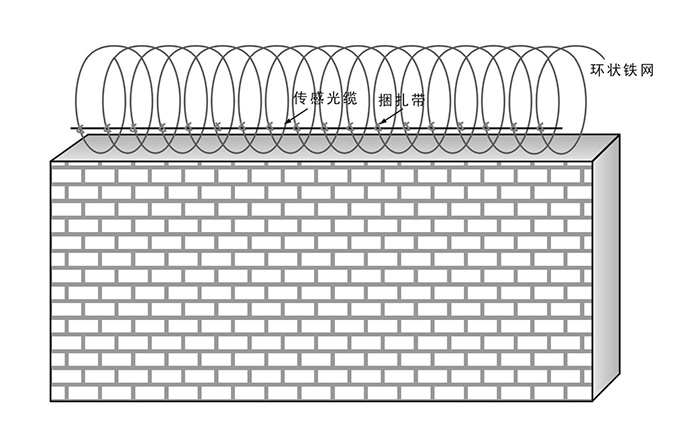 In the project process of the security industry, perimeter alarm equipment is an important part, and vibration fiber optic perimeter alarm products are the best configuration to replace traditional electronic fences and infrared camera monitoring. But many people don’t know what a vibration fiber optic host is. Below, FJINNO will tell you what a vibration fiber optic alarm system is.
In the project process of the security industry, perimeter alarm equipment is an important part, and vibration fiber optic perimeter alarm products are the best configuration to replace traditional electronic fences and infrared camera monitoring. But many people don’t know what a vibration fiber optic host is. Below, FJINNO will tell you what a vibration fiber optic alarm system is.
Introduction to Vibration Fiber Optics
Vibration optical fibers, vibration optical cables, and vibration optical cables are commonly referred to as vibration optical fibers. The main installation plan is to lay and wrap around the surrounding fence or wall of the tested object. The main security installation method is to choose the installation method of light vibration according to the customer’s needs and the type of perimeter, such as hanging mesh, buckle mesh, buried and other different installation methods. Divide the scope of this vibration monitoring into different defense zones, and then transmit the alarm information back to the system industrial computer through optical fibers. Then locate the location of the abnormal vibration alarm on the GIS map.
Vibration fiber optic is divided into two equipment deployment modes;
1. Distributed vibration fiber dual zone host
The defense zone host is divided into single defense zone and double defense zone, consisting of one or more vibration fiber optic alarm systems. In the control center, the alarm host is added with modules to each host for receiving signals and deploying defenses.
2. One cable vibration fiber optic host
The defense zone is composed of a single or multiple defense zone relays, and the front-end equipment is installed passively. In the control center, there is an alarm control device used for adjusting defense zone parameters, displaying alarm information, deploying and disarming, and can be connected to a computer for management using alarm software. The latest waveform analysis software developed by Shanghai and Shi can distinguish alarms generated by different situations such as wind, rain, small animals, and knocking. By analyzing the characteristics of the waveform changes, the software can distinguish the true situation of the event and filter out unnecessary alarms, minimizing the false alarm rate.
What is the composition of a vibrating fiber optic host
The optical cable vibration sensing alarm system consists of five main parts: monitor, main controller, sensor, sensing optical cable, and external components. Iwaena o lakou, the system monitor and main controller are located in the monitoring room, and the guiding optical cable, sensing optical cable, and external components are installed outdoors.
The working principle of vibrating optical fibers:
When fiber optic sensors are affected by external interference, some of the characteristics of the transmitted light in the fiber optic will change. By configuring special sensing equipment and collecting and analyzing signals, changes in the characteristics of the light (i.e. attenuation, pae, lōʻihi nalu, polarization, mode field distribution, and propagation time) can be detected. The characteristic changes of light are distinguished from normal interference by the special algorithms and analysis processing of the alarm controller, achieving alarm and positioning functions.
Composition of vibration fiber optic signal acquisition host
Mainly based on the principle of “fiber optic interferometer”. In order to detect weak vibrations, a balanced fiber optic interferometer is constructed using two core single-mode fibers. When a coherent laser is emitted from it, the interferometer composed of these two fibers outputs an interference light signal. When the fiber optic is disturbed by external factors such as excavation, touch, and tapping, the output waveform of the interference light changes and generates an interference image. This waveform change can be detected by a light detector. By analyzing the characteristics of the changed waveform through software, the true situation of the event can be distinguished, thus achieving the effect of “intrusion pattern recognition”.
The following is for reference only and does not represent the latest parameters of the specific host. Please contact FJINNO for detailed product information
Positioning vibration fiber optic host parameters:
Positioning accuracy, spatial resolution, full range: ± 1m
Maximum detection distance: 6okm
Response time: 2s
Monitoring range: Within 25 meters on both sides of the optical cable
System sensitivity: 100%
Working temperature and humidity: indoor 0 ° C~+40 ° C, outdoor -45C~+70 ° C, humidity 10% -95%
Power supply: AC220V main 10%
Leakage current: 5mA
LED indicator lights: working status indication, alarm indication, fault indication
Power supply: including supporting equipment such as power supply
Power consumption: 25ow
Size (mm): 19 inch standard 4U chassis
ʻIke wela optic, Pūnaehana nānā naʻauao, Hāʻawi ʻia ka mea hana fiber optic ma Kina
 |
 |
 |
 INNO nā mea ʻike wela optic ,ʻōnaehana nānā wela.
INNO nā mea ʻike wela optic ,ʻōnaehana nānā wela.
